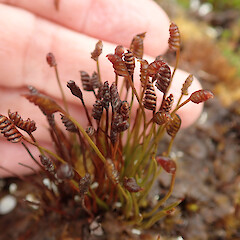Microschizaea australis
Common name
southern comb fern
Synonyms
Schizaea australis Gaudich., Schizaea fistulosa var. australis (Gaudich.) Hook. f.
Family
Schizaeaceae
Flora category
Vascular – Native
Endemic taxon
No
Endemic genus
No
Endemic family
No
Structural class
Ferns
NVS code
The National Vegetation Survey (NVS) Databank is a physical archive and electronic databank containing records of over 94,000 vegetation survey plots - including data from over 19,000 permanent plots. NVS maintains a standard set of species code abbreviations that correspond to standard scientific plant names from the Ngä Tipu o Aotearoa - New Zealand Plants database.
SCHAUS
Chromosome number
2n = 188
Current conservation status
The conservation status of all known New Zealand vascular plant taxa at the rank of species and below were reassessed in 2017 using the New Zealand Threat Classification System (NZTCS) – more information about this can be found on the NZTCS website. This report includes a statistical summary and brief notes on changes since 2012 and replaces all previous NZTCS lists for vascular plants.
Please note, threat classifications are often suggested by authors when publications fall between NZTCS assessment periods – an interim threat classification status has not been assessed by the NZTCS panel.
- Conservation status of New Zealand indigenous vascular plants, 2017 . 2018. Peter J. de Lange, Jeremy R. Rolfe, John W. Barkla, Shannel P. Courtney, Paul D. Champion, Leon R. Perrie, Sarah M. Beadel, Kerry A. Ford, Ilse Breitwieser, Ines Schönberger, Rowan Hindmarsh-Walls, Peter B. Heenan and Kate Ladley. Department of Conservation. Source: NZTCS and licensed by DOC for reuse under the Creative Commons Attribution 4.0 International licence.
2017 | Not Threatened
Previous conservation statuses
2012 | Not Threatened
2009 | Not Threatened
2004 | Not Threatened
Distribution
Indigenous. New Zealand: North Island (from Te Moehau south but scarce north of the Volcanic Plateau), South Island (primarily found west of the main divide), Stewart Island/Rakiura, Chatham Islands (uncommon), Auckland Islands and Campbell Island/Motu Ihupuku. Also South America and Falkland Islands.
Habitat
In peat bogs, pakihi, fell field, cushion bogs and in poorly drained tussock grassland or in marginal turf communities fringing lakes, tarns and ephemeral pools in forested and open areas.
Wetland plant indicator status rating
Information derived from the revised national wetland plant list prepared to assist councils in delineating and monitoring wetlands (Clarkson et al., 2021 Manaaki Whenua – Landcare Research Contract Report LC3975 for Hawke’s Bay Regional Council). The national plant list categorises plants by the extent to which they are found in wetlands and not ‘drylands’. The indicator status ratings are OBL (obligate wetland), FACW (facultative wetland), FAC (facultative), FACU (facultative upland), and UPL (obligate upland). If you have suggestions for the Wetland Indicator Status Rating, please contact: [Enable JavaScript to view protected content]
FAC: Facultative
Commonly occurs as either a hydrophyte or non-hydrophyte (non-wetlands).
Detailed description
Tufted terrestrial fern. Rhizomes short-creeping, slender, hairy. Frond glabrous, reed-like, undivided, green or pale brown. Stipe 20–150 mm long, 0.25–0.5 mm diameter, erect, wiry, smooth. Laminae at stipe apices, pinnate, 4–15 mm long, pinnae fertile in 4–8 pairs, 1–4 mm long, infolded. Sporangia in one row either side of midrib.
Similar taxa
Allied to Microschizaea fistulosa from which it differs by its usually smaller size (stipe 20–150 mm cf. 100–500 mm long in M. fistulosa), smaller fertile laminae (4–15 mm cf. 7–30 mm in M. fistulosa), slightly smaller pinnae (1–4 mm cf. 1–5 mm long in M. fistulosa), ecological preference for montane and subantarctic habitats, and perhaps most convincingly by its different chromosome number (2n = 188 cf. 2n= 388, 540 in M. fistulosa). The distinctiveness of Microschizaea australis from M. fistulosa was confirmed by Ke et al. (2022).
Flowering
N.A.
Flower colours
No flowers
Fruiting
N.A.
Propagation technique
Difficult—should not be removed from the wild.
Etymology
australis: Southern
Where To Buy
Not commercially available
Attribution
Fact Sheet Prepared for NZPCN by: P.J. de Lange (10 March 2011). Description modified from Brownsey & Smith-Dodsworth (2000).
References and further reading
Brownsey PJ, Smith-Dodsworth JC. 2000. New Zealand Ferns and Allied Plants. David Bateman, Auckland, NZ. 168 p.
Ke B-F, Wang G-J, Labiak PH, Rouhan G on behalf of the GoFlag Consortium, Chen C-W, Shepherd LD, Ohlsen DJ, Renner MAM, Karol KG, Li F-W, Kuo L-Y. 2022. Systematics and Plastome Evolution in Schizaeaceae. Frontiers in Plant Science 3: 885501. https://doi.org/10.3389/fpls.2022.885501.
NZPCN Fact Sheet citation
Please cite as: de Lange, P.J. (Year at time of access): Microschizaea australis Fact Sheet (content continuously updated). New Zealand Plant Conservation Network. https://www.nzpcn.org.nz/flora/species/microschizaea-australis/ (Date website was queried)






